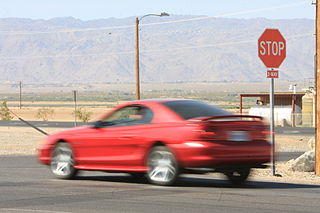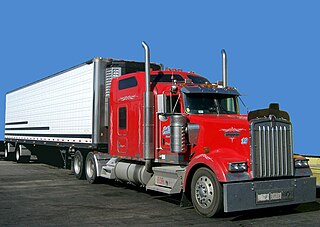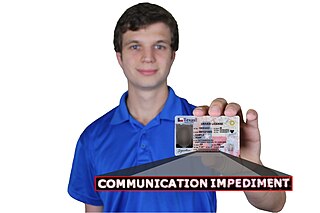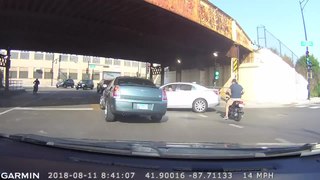
Driving is the controlled operation and movement of a land vehicle, including cars, motorcycles, trucks, and buses. Permission to drive on public highways is granted based on a set of conditions being met and drivers are required to follow the established road and traffic laws in the location they are driving. The word driving, has etymology dating back to the 15th century and has developed as what driving has encompassed has changed from working animals in the 15th to automobiles in the 1800s. Driving skills have also developed since the 15th century with physical, mental and safety skills being required to drive. This evolution of the skills required to drive have been accompanied by the introduction of driving laws which relate to not only the driver but the driveability of a car.

A department of motor vehicles (DMV) is a government agency that administers motor vehicle registration and driver licensing. In countries with federal states such as in North America, these agencies are generally administered by subnational entities governments, while in unitary states such as many of those in Europe, DMVs are organized nationally by the central government.

A moving violation or traffic violation is any violation of the law committed by the driver of a vehicle while it is in motion. The term "moving" distinguishes it from other motor vehicle violations, such as paperwork violations, parking violations, or equipment violations. The United States Department of State makes reference to moving violations in its enforcement guidance.

A traffic ticket is a notice issued by a law enforcement official to a motorist or other road user, indicating that the user has violated traffic laws. Traffic tickets generally come in two forms, citing a moving violation, such as exceeding the speed limit, or a non-moving violation, such as a parking violation, with the ticket also being referred to as a parking citation, or parking ticket.
License suspension or revocation traditionally follows conviction for alcohol-impaired or drunk driving. However, under administrative license suspension (ALS) laws, sometimes called administrative license revocation or administrative per se, licenses are confiscated and automatically suspended independent of criminal proceedings whenever a driver either (1) refuses to submit to chemical testing, or (2) submits to testing with results indicating a blood alcohol content of 0.08% or higher.

A commercial driver's license (CDL) is a driver's license required in the United States to operate large and heavy vehicles or a vehicle of any size that transports hazardous materials or more than 15 passengers.
The Non-Resident Violator Compact (NRVC) is a United States interstate compact used by 44 states and Washington, D.C. to process traffic citations across state borders.
In the United States, the Driver License Agreement (DLA) is an interstate compact written by the Joint Executive Board of the Driver License Compact (DLC) and the Non-Resident Violator Compact (NRVC) with staff support provided by the American Association of Motor Vehicle Administrators (AAMVA). The DLA requires all states to honor licenses issued by other member states, report traffic convictions to the licensing state, prohibit a member state from confiscating an out-of-state driver's license or jailing an out-of-state driver for a minor violation; and maintain a complete driver's history, including withdrawals and traffic convictions including those committed in non-DLA states.
Under traffic violations reciprocity agreements, non-resident drivers are treated like residents when they are stopped for a traffic offense that occurs in another jurisdiction. They also ensure that punishments such as penalty points on one's license and the ensuing increase in insurance premiums follow the driver home. The general principle of such interstate, interprovincial, and/or international compacts is to guarantee the rule "one license, one record."
The American Association of Motor Vehicle Administrators (AAMVA) is a non-governmental, voluntary, tax-exempt, nonprofit educational association. AAMVA is a private corporation which strives to develop model programs in motor vehicle administration, police traffic services, and highway safety.
The National Driver Register (NDR) is a computerized database of information about United States drivers who have had their driver's licenses revoked or suspended, or who have been convicted of serious traffic violations, such as driving under the influence or drugs or alcohol.. The records are added and maintained and deleted by the motor vehicle agency (MVA) of the state that convicted the driver or withdrew the driver's license.
Many countries have adopted a penalty point or demerit point system under which a person’s driving license is revoked or suspended based on the number of points they’ve accumulated over a specific period of time, points are given for traffic offenses or infringements committed by them in that period. The demerit points schemes of each jurisdiction varies. These demerit schemes are usually in addition to fines or other penalties which may be imposed for a particular offence or infringement, or after a prescribed number of points have been accumulated.
Mandated by the Commercial Motor Vehicle Safety Act 1986 (CMVSA) and revised in accordance with various other federal laws subsequent to CMVSA, CDLIS helps document the issuance of a Commercial driver's license (CDL) and the withdrawal of a commercial driver by the State Driver Licensing Agencies (SDLAs) of the CDLIS jurisdictions. The purpose of CDLIS is to keep a record of each driver nationwide and help ensure only one driver license and one record for each driver and to enable authorized users nationwide, such as local law enforcement officials, to check whether a driver is withdrawn, through the cooperative exchange of commercial driver information between the CDLIS jurisdictions.

In the United States, driver's licenses are issued by each individual state, territory, and the District of Columbia rather than by the federal government due to federalism. Drivers are normally required to obtain a license from their state of residence. All states of the United States and provinces and territories of Canada recognize each other's licenses for non-resident age requirements. There are also licenses for motorcycle use. Generally, a minimum age of 15 is required to apply for a non-commercial driver license, and 25 for commercial licenses which drivers must have to operate vehicles that are too heavy for a non-commercial licensed driver or vehicles with at least 16 passengers or containing hazardous materials that require placards. A state may also suspend an individual's driving privilege within its borders for traffic violations. Many states share a common system of license classes, with some exceptions, e.g. commercial license classes are standardized by federal regulation at 49 CFR 383. Many driving permits and ID cards display small digits next to each data field. This is required by the American Association of Motor Vehicle Administrators' design standard and has been adopted by many US states. According to the United States Department of Transportation, as of 2018, there are approximately 227 million licensed drivers in the United States.
In Taiwan, driver's licenses (駕駛執照) are issued by the Ministry of Transportation and Communications to a qualified motor vehicle driver. The number on a license is the same as the ID number of the license holder's household registration in Taiwan. In Taiwan, the license is sometimes accepted as a valid identity document, as its information replicates most of what is on a National Identification Card.

In traffic laws, a hit and run or a hit-and-run is the criminal act of causing a traffic collision and not stopping afterwards. It is considered a supplemental crime in most jurisdictions.
Criminal records in the United States contain records of arrests, criminal charges and the disposition of those charges. Criminal records are compiled and updated on local, state, and federal levels by government agencies, most often law enforcement agencies. Their primary purpose is to present a comprehensive criminal history for a specific individual.

A driver's license, driving licence, or driving permit is a legal authorization, or the official document confirming such an authorization, for a specific individual to operate one or more types of motorized vehicles—such as motorcycles, cars, trucks, or buses—on a public road. Such licenses are often plastic and the size of a credit card.
The Interstate Wildlife Violator Compact (IWVC) is a United States interstate compact to provide reciprocal sharing of information regarding sportsman fishing, hunting, and trapping violations and allows for recognition of suspension or revocation of hunting, fishing, and trapping licenses and permits in other member states resulting from violations concerning hunting, fishing and trapping laws in order to prevent poaching across state lines. All 50 US states are members of the compact.
Regulation of self-driving cars, autonomous vehicles and automated driving system is an increasingly relevant topic in the automotive industry strongly related to the success of the actual technology. Multiple countries have passed local legislation and agreed on standards for the introduction of autonomous cars.